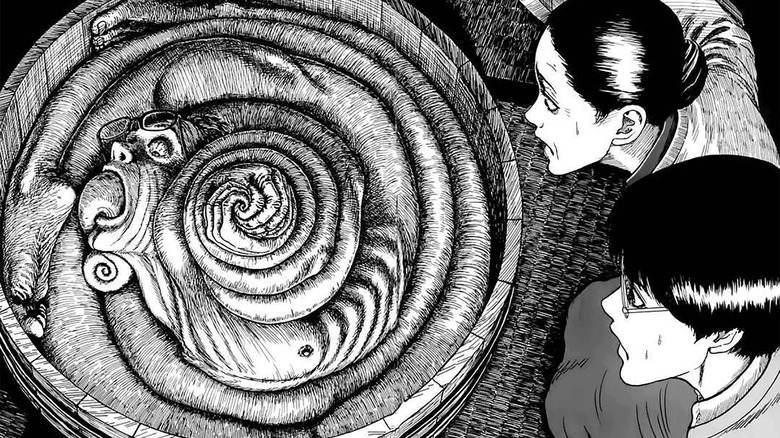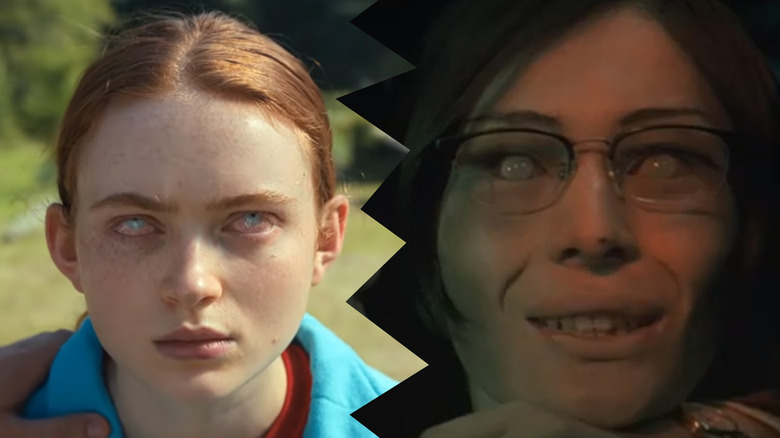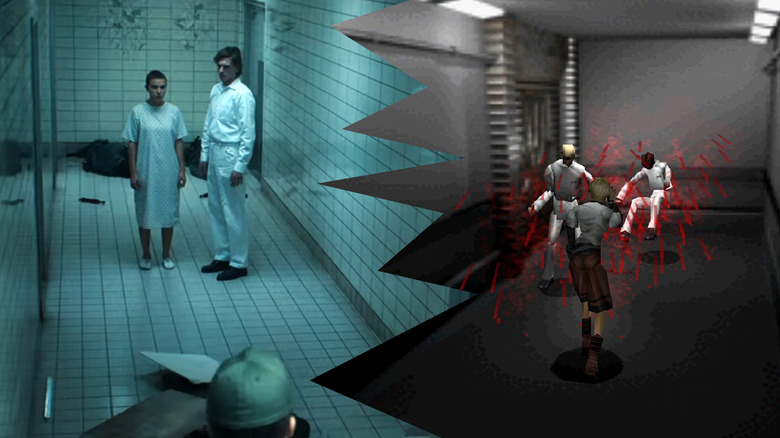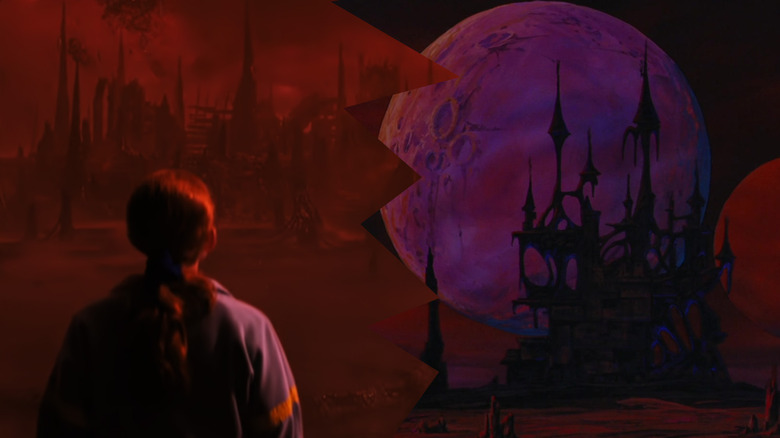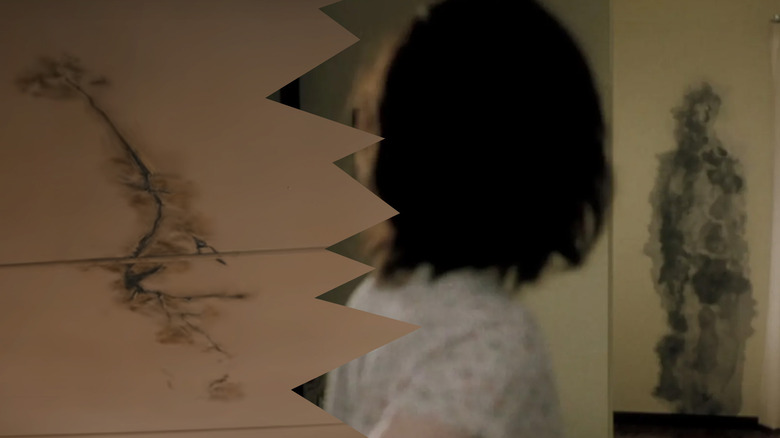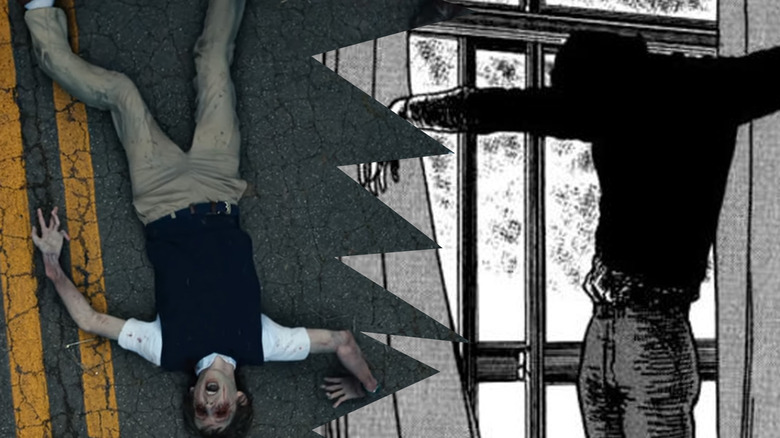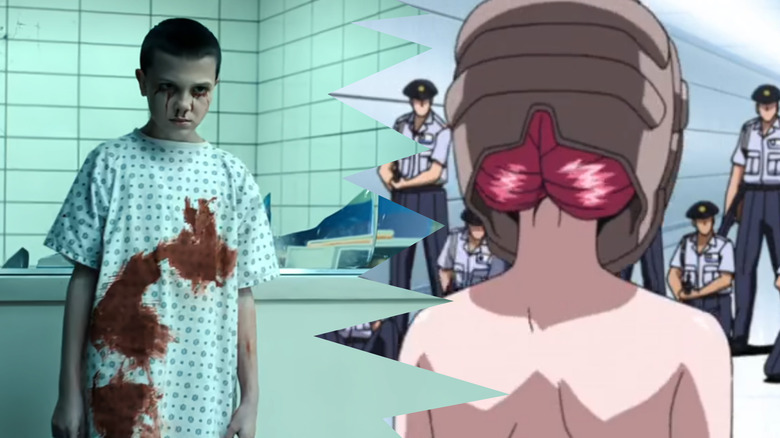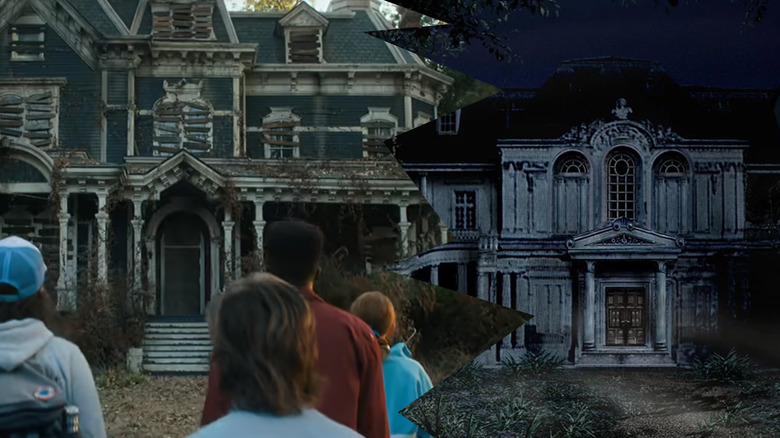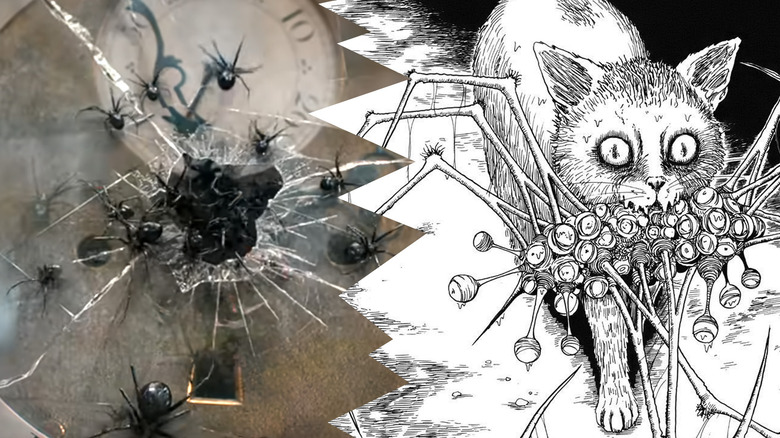Stranger Things Season 4 Feels Like A J-Horror Junji Ito Video Game
People both love and hate "Stranger Things" for its many references to pop culture, riffing on everything from Stephen King to Steven Spielberg. Season 4 took some interesting new directions, however, channeling Japanese horror comics, movies, and video games. The season pays homage to both major titles and little-known cult classics, and it gives "Stranger Things" an injection of otherworldly weirdness inspired by some of the greats, including manga artist and author Junji Ito.
The Japanese creative's influence on "Stranger Things" is undeniable, from its various visual depictions of monsters and supernatural events to Ito's unique flair for body horror. Japanese horror generally has a different flavor than American versions of the genre, and there are traces of it throughout the latest season. Let's dive into all of the incredible J-horror influences in season 4, vol. 1 of "Stranger Things," featuring lots of Ito, some Playstation 1 classics, beloved anime, and more.
Spoilers ahead for "Stranger Things" season 4, vol. 1, along with some graphic imagery from both the series and its influences. Reader discretion is advised.
The eyes of the possessed
In "Stranger Things" season 4, the eyes of Vecna's victims — specifically their pupils and irises — go white, while the rest of their eye becomes bloodshot. The possessed have had whited-out eyes in many pop culture franchises, including "The Evil Dead" and "The Exorcist," but the exact appearance of Vecna's victims looks closer to the eyes of the possessed in the 2000 film "Uzumaki," based on the manga of the same name by Junji Ito. "Uzumaki" was directed by Higuchinsky and is a Japanese-language horror nightmare that brings Ito's panels to life in inventive ways.
"Uzumaki" translates to "spiral," and in the manga and film, the residents of a small town in Japan become possessed by the idea of the spiral. Anything with a spiral in it either drives them to ecstasy or panic and eventually, the spiral begins infecting the very world around them. It's hard to tell what's a vision and what's really happening in parts of "Uzumaki," much like "Stranger Things" with its visions from Vecna.
Ito is a master of existential, cosmic, and body horror, so he's the perfect fit for "Stranger Things" inspiration. Fans of "Uzumaki" — the manga or the movie — will get a chance to scream once more when the adult swim adaptation comes out in October 2022.
A little-known PlayStation classic about telekinetic teens
A big chunk of "Stranger Things" season 4 revolves around Eleven (Millie Bobby Brown) going back to the facility where she was raised in order to try and regain her telekinetic powers. While there, she unlocks some of the memories that her brain had repressed because they were traumatizing, and in unlocking her memories she begins to unlock her extrasensory powers once more. Both the story and visuals are reminiscent of the 1999 survival horror game "Galerians," which later had a sequel, "Galerians: Ash" in 2002, and a computer-generated anime adaptation called "Galerians: Rion" in 2003.
"Galerians" tells the story of Rion, a teenage boy with incredible psychic powers and a nasty case of amnesia. Over the course of the game, he both unlocks his memories and additional powers and eventually, he fights the monsters created by the same lab that created him. In the end, he must fight another one of the children from the same lab, with terrible consequences that shake both the real world and the monstrous one.
Sound familiar? Rion even uses his main telekinetic power, which pops people's heads like grapes, by sticking out one hand and concentrating. Also, the effort sometimes gives him nosebleeds. It may be extremely dated, but anyone who likes "Stranger Things" and video games should give "Galerians" a shot. They are two sides of the same bloody coin.
A world of monsters
When Max (Sadie Sink) enters the Upside Down and ends up in Vecna's lair, it's a barren wasteland with spires and floating clocks and doors, stained red in every direction. Fans have seen the Upside Down plenty of times in previous seasons, but Vecna's clearly inhabiting a different part or has made an imprint.
His mind castle and the world around it look a whole lot like the world from the original video animation (OVA) "Vampire Hunter D" from 1985. The OVA is a visual feast, and the connections between Vecna's lair and the pointed castle of "Vampire Hunter D" are pretty apparent. "Vampire Hunter D" would go on to inspire other major Japanese horror classics, including the video game series "Castlevania," which debuted in 1986 and also has its fair share of visual references in the show's depiction of spooky places.
A stain left by loss
Luckily, Max is able to find her way out of Vecna's trap when her friends put on her favorite song, but for those who aren't so lucky, there's an interesting mark left on the world in the exact place they departed it. The cheerleader Chrissy (Grace Van Dien) was killed on the ceiling of the Munson's trailer, and in the exact place that she died, a moldy stain begins to grow.
The crew eventually figures out that there are gates between Hawkins and the Upside Down anywhere that the murders took place, and that stain soon becomes a gate much like the one at the bottom of Lovers' Lake. Both the appearance and reason behind the stain bring to mind the 2001 Kiyoshi Kurosawa film "Pulse," which tells the story of a curse that makes people disappear, leaving a moldy stain behind in the place where they died. "Pulse" is sheer existential dread with a science-fiction component, and it's an unsung early-2000s J-horror masterpiece that seems to be leaving its mark on this season.
Broken bodies are Ito's specialty
While much of Ito's body horror involves people turning into monsters, sometimes he just likes depicting the human body in broken, disturbing ways.
Vecna's victims have their bones snapped and their limbs bent at unnatural angles, their mouths hanging open in abject horror before their eyes are yanked backward into their skulls. Their faces are somewhat reminiscent of those who die in "Ringu," but the overall motif feels more closely related to Ito's many gruesome manga stories throughout his career. In "The Earthbound," people begin appearing trapped in strange poses all over Japan, floating in the air and unable to move. In "Uzumaki," one of the possessed crawls into the clothes washing machine in order to become part of the spiral himself, and every bone breaks until he is just a sack of meat in a spiral.
No one draws supernatural injury quite like Ito, and his demented vision is all over "Stranger Things" season 4.
A facility that facilitates bloodshed
"Stranger Things" showrunners the Duffer brothers have been open about taking inspiration from the 2004 anime series "Elfen Lied," based on the manga of the same name. The controversial series follows the genetically advanced Diclonius, who are young, human-looking beings with small horns on their heads and incredible telekinetic powers using invisible hands. The opening sequence of the anime series features its main character, Lucy, escaping the facility where she was created and studied. She kills everyone in her path with her mind powers, leaving a bloody mess in her wake. The character of Eleven was inspired by Lucy, and in season 4 we see her in some of the positions both Lucy and her younger sisters, Nana and Number 3 were in during the brutal anime series.
"Elfen Lied" features significantly more adult content than "Stranger Things," so it's not one to watch with younger fans of the series who want more psychic horror goodness. For those who don't mind taking the plunge into what the Duffers called "ultraviolent 'E.T.'," this is one to make a point of checking out. Just prepare to have your feelings wrecked.
Everyone loves a spooky mansion
The "Stranger Things" Scooby gang eventually figure out that they have to look for clues in Victor Creel's mansion, and when they get there it is eerily familiar. Sure, there are loads of mansions in horror properties, ranging back to films like 1959's "House on Haunted Hill," but the appearance and presentation of the Creel house looks a little more like those in Japanese horror games like "Resident Evil" and the Japanese-only 1989 game and film that inspired it, "Sweet Home." ("Sweet Home" was itself inspired by the 1977 Japanese film "Hausu.")
The dilapidated mansions of these games and movies are inspired by Victorian Gothic architecture, twisted slightly through a horror lens. Exploring the hallways haunted by more than ghosts in these games is truly terrifying, and watching Dustin (Gaten Matarazzo), Steve (Joe Keery), and the rest of the gang walk those warped halls is just as scary.
Creepy crawlies
Last but definitely not least, Vecna has a deep fondness for spiders, and we see them crawling out of clocks, shadows, and many other things and places where they don't belong.
While arachnophobia (the fear of spiders) is fairly common, Junji Ito often takes our fear of the spindly-legged web-spinners to new heights. There are tons of spiders and spider-influenced monsters in Ito's work, especially "Souichi's Diary of Curses." Souichi begins cursing others with Voodoo dolls and spiders, creating some horrifying visuals with the eight-legged critters. This includes some giant spiders and horrifying hybrids, like the one that poor Souichi's cat picks up and eventually eats.
Spiders are already pretty scary, but horror master Junji Ito can make them even scarier. "Stranger Things" pulled from his work to create its own spidery spookiness to great effect.
"Stranger Things" season 4 vol. 1 is now streaming on Netflix.
